

Compact Muon Solenoid
LHC, CERN
| CMS-HIG-21-020 ; CERN-EP-2024-162 | ||
| Measurement of boosted Higgs bosons produced via vector boson fusion or gluon fusion in the $ \mathrm{H}\to\mathrm{b}\overline{\mathrm{b}} $ decay mode using LHC proton-proton collision data at $ \sqrt{s} = $ 13 TeV | ||
| CMS Collaboration | ||
| 10 July 2024 | ||
| JHEP 12 (2024) 035 | ||
| Abstract: A measurement is performed of Higgs bosons produced with high transverse momentum ($ p_{\mathrm{T}} $) via vector boson or gluon fusion in proton-proton collisions. The result is based on a data set with a center-of-mass energy of 13 TeV collected in 2016-2018 with the CMS detector at the LHC and corresponds to an integrated luminosity of 138 fb$ ^{-1} $. The decay of a high-$ p_{\mathrm{T}} $ Higgs boson to a boosted bottom quark-antiquark pair is selected using large-radius jets and employing jet substructure and heavy-flavor taggers based on machine learning techniques. Independent regions targeting the vector boson and gluon fusion mechanisms are defined based on the topology of two quark-initiated jets with large pseudorapidity separation. The signal strengths for both processes are extracted simultaneously by performing a maximum likelihood fit to data in the large-radius jet mass distribution. The observed signal strengths relative to the standard model expectation are 4.9$ ^{+1.9}_{-1.6} $ and 1.6$ ^{+1.7}_{-1.5} $ for the vector boson and gluon fusion mechanisms, respectively. A differential cross section measurement is also reported in the simplified template cross section framework. | ||
| Links: e-print arXiv:2407.08012 [hep-ex] (PDF) ; CDS record ; inSPIRE record ; HepData record ; CADI line (restricted) ; | ||
| Figures & Tables | Summary | Additional Figures | References | CMS Publications |
|---|
| Figures | |

png pdf |
Figure 1:
Lowest order Feynman diagrams of the Higgs boson production modes with highest cross section in 13 TeV proton-proton collisions, from left to right: gluon fusion, vector boson fusion, and vector boson associated production. |
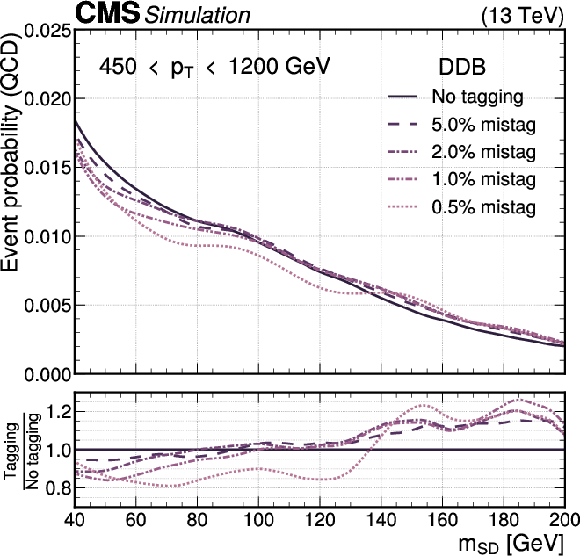
png pdf |
Figure 2:
Soft drop mass distribution in simulated QCD events after applying the DDB selection at different working points. The distributions are obtained from simulated QCD events, smoothed using Gaussian kernel density estimation, and normalized to unit area. The lower panel shows the ratio to the inclusive distribution. |
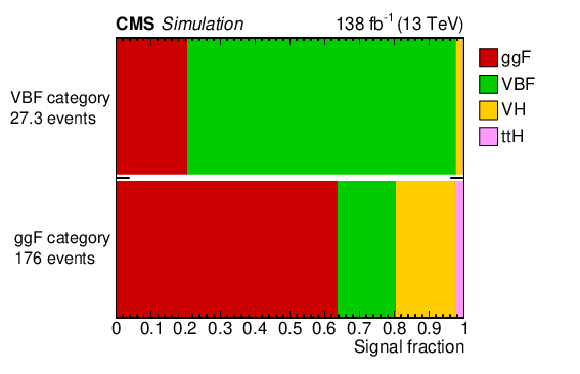
png pdf |
Figure 3:
Simulated relative contributions of the four leading H production processes to the total H signal yield in the VBF and ggF categories, shown in the DDB pass region. Small contributions from the VH and $ {\mathrm{t}\overline{\mathrm{t}}} \mathrm{H} $ processes are also included. The total number of predicted H events in the 138 fb$ ^{-1} $ dataset are 27.3 and 176 in the VBF and ggF categories, respectively. |
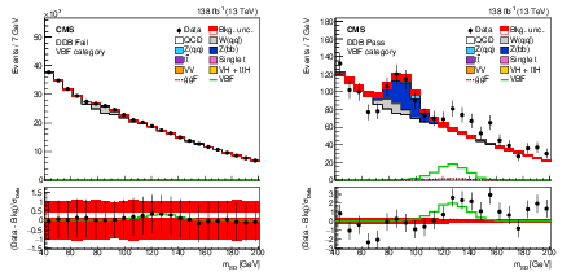
png pdf |
Figure 4:
Post-fit soft drop mass distribution in the VBF category, summed over all $ m_\text{jj} $ bins and data-taking periods for display purposes. The DDB fail (left) and pass (right) regions are shown. The total background is broken down into contributions from different processes, and the total uncertainty is shown as a red band. The lower panels show the difference between the data and background prediction divided by the statistical uncertainty in data. The near-perfect model agreement with data in the DDB fail region is by construction. The ggF and VBF distributions are overlaid in red and green, respectively. Each signal is scaled to its fitted event yield. |

png pdf |
Figure 4-a:
Post-fit soft drop mass distribution in the VBF category, summed over all $ m_\text{jj} $ bins and data-taking periods for display purposes. The DDB fail (left) and pass (right) regions are shown. The total background is broken down into contributions from different processes, and the total uncertainty is shown as a red band. The lower panels show the difference between the data and background prediction divided by the statistical uncertainty in data. The near-perfect model agreement with data in the DDB fail region is by construction. The ggF and VBF distributions are overlaid in red and green, respectively. Each signal is scaled to its fitted event yield. |

png pdf |
Figure 4-b:
Post-fit soft drop mass distribution in the VBF category, summed over all $ m_\text{jj} $ bins and data-taking periods for display purposes. The DDB fail (left) and pass (right) regions are shown. The total background is broken down into contributions from different processes, and the total uncertainty is shown as a red band. The lower panels show the difference between the data and background prediction divided by the statistical uncertainty in data. The near-perfect model agreement with data in the DDB fail region is by construction. The ggF and VBF distributions are overlaid in red and green, respectively. Each signal is scaled to its fitted event yield. |
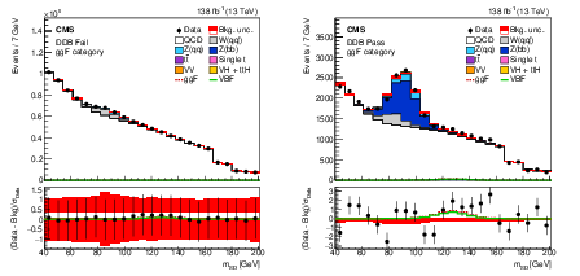
png pdf |
Figure 5:
Post-fit soft drop mass distribution in the ggF category, summed over all $ p_{\mathrm{T}} $ bins and data-taking periods for display purposes. The DDB fail (left) and pass (right) regions are shown. The total background is broken down into contributions from different processes, and the total uncertainty is shown as a red band. The lower panels show the difference between the data and background prediction divided by the statistical uncertainty in data. The near-perfect model agreement with data in the DDB fail region is by construction. The ggF and VBF distributions are overlaid in red and green, respectively. Each signal is scaled to its fitted event yield. The apparent discontinuity at high mass is due to the exclusion of bins with extreme values of $ \rho $. |

png pdf |
Figure 5-a:
Post-fit soft drop mass distribution in the ggF category, summed over all $ p_{\mathrm{T}} $ bins and data-taking periods for display purposes. The DDB fail (left) and pass (right) regions are shown. The total background is broken down into contributions from different processes, and the total uncertainty is shown as a red band. The lower panels show the difference between the data and background prediction divided by the statistical uncertainty in data. The near-perfect model agreement with data in the DDB fail region is by construction. The ggF and VBF distributions are overlaid in red and green, respectively. Each signal is scaled to its fitted event yield. The apparent discontinuity at high mass is due to the exclusion of bins with extreme values of $ \rho $. |
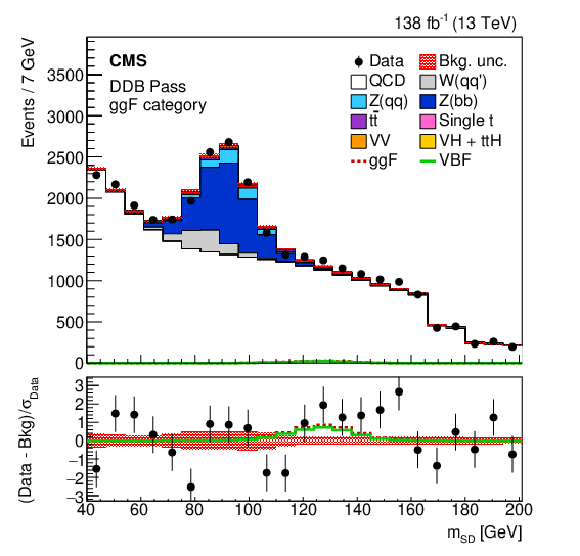
png pdf |
Figure 5-b:
Post-fit soft drop mass distribution in the ggF category, summed over all $ p_{\mathrm{T}} $ bins and data-taking periods for display purposes. The DDB fail (left) and pass (right) regions are shown. The total background is broken down into contributions from different processes, and the total uncertainty is shown as a red band. The lower panels show the difference between the data and background prediction divided by the statistical uncertainty in data. The near-perfect model agreement with data in the DDB fail region is by construction. The ggF and VBF distributions are overlaid in red and green, respectively. Each signal is scaled to its fitted event yield. The apparent discontinuity at high mass is due to the exclusion of bins with extreme values of $ \rho $. |
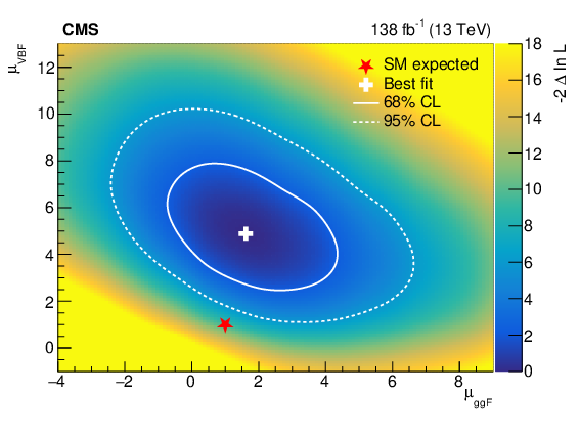
png pdf |
Figure 6:
Two-dimensional likelihood contour of the VBF and ggF signal strengths. The color scale represents twice the negative log likelihood difference with respect to the best fit point. The observed 95% (dashed) and 68% (solid) contours are shown in white, and the best fit point as a white cross. The SM expectation is marked by a red star. |
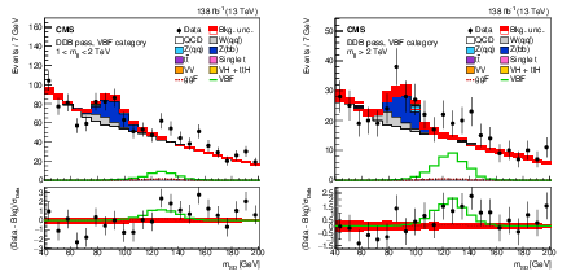
png pdf |
Figure 7:
Post-fit soft drop mass distribution in each of the two $ m_\text{jj} $ bins in the VBF category, summed over all data-taking periods for display purposes. The DDB pass region is shown. The lower panels show the difference between the data and background prediction divided by the statistical uncertainty in data. The ggF and VBF distributions are overlaid in red and green, respectively. Each signal is scaled to its fitted event yield. |
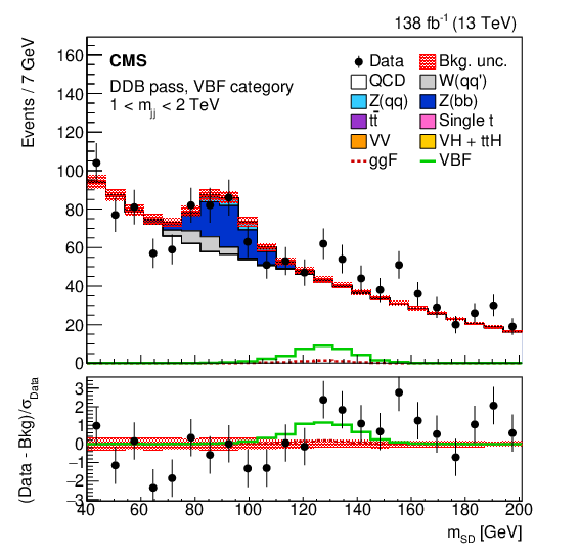
png pdf |
Figure 7-a:
Post-fit soft drop mass distribution in each of the two $ m_\text{jj} $ bins in the VBF category, summed over all data-taking periods for display purposes. The DDB pass region is shown. The lower panels show the difference between the data and background prediction divided by the statistical uncertainty in data. The ggF and VBF distributions are overlaid in red and green, respectively. Each signal is scaled to its fitted event yield. |
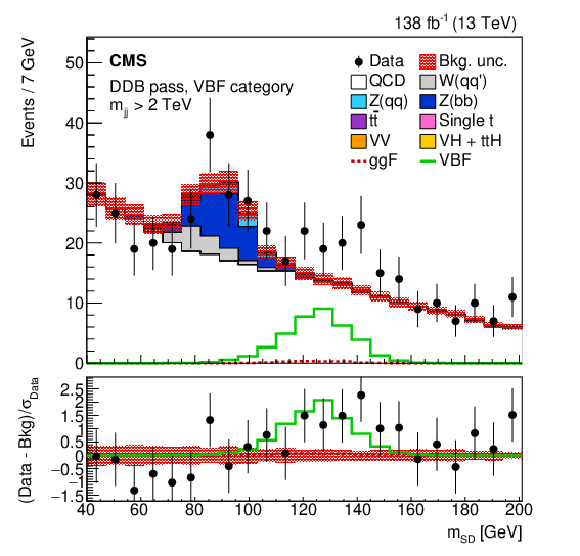
png pdf |
Figure 7-b:
Post-fit soft drop mass distribution in each of the two $ m_\text{jj} $ bins in the VBF category, summed over all data-taking periods for display purposes. The DDB pass region is shown. The lower panels show the difference between the data and background prediction divided by the statistical uncertainty in data. The ggF and VBF distributions are overlaid in red and green, respectively. Each signal is scaled to its fitted event yield. |
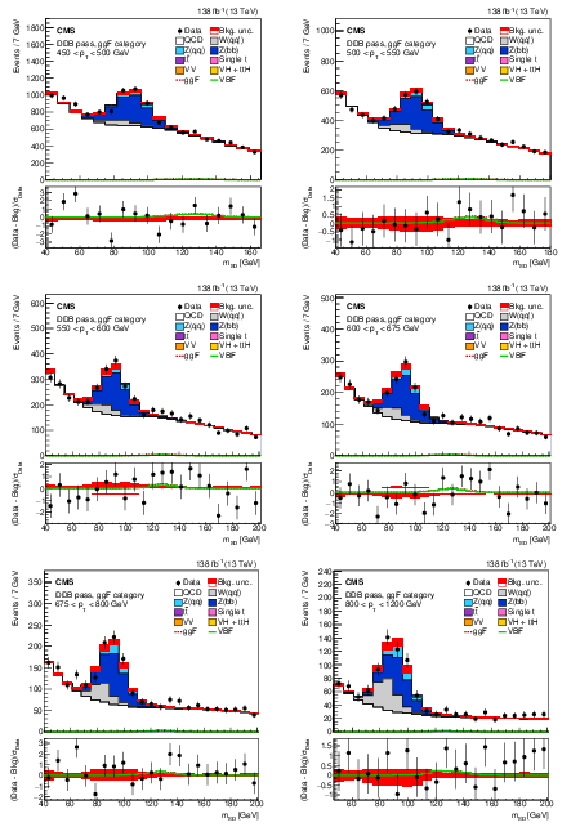
png pdf |
Figure 8:
Post-fit soft drop mass distribution in each of the $ {p_{\mathrm{T}}} $ bins in the ggF category, summed over all data-taking periods for display purposes. The DDB pass region is shown. The lower panels show the difference between the data and background prediction divided by the statistical uncertainty in data. The ggF and VBF distributions are overlaid in red and green, respectively. Each signal is scaled to its fitted event yield. |
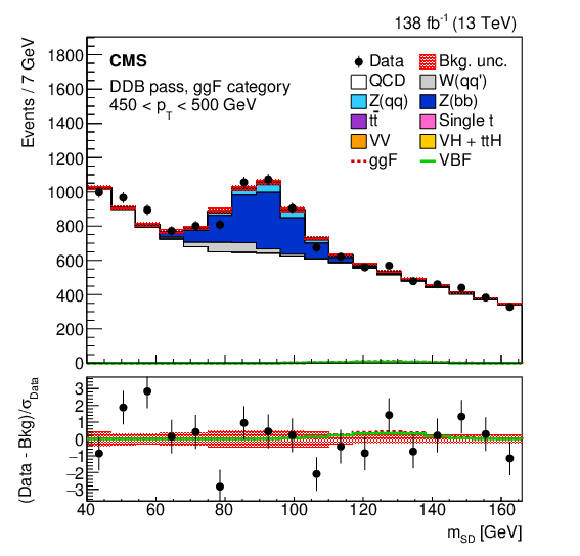
png pdf |
Figure 8-a:
Post-fit soft drop mass distribution in each of the $ {p_{\mathrm{T}}} $ bins in the ggF category, summed over all data-taking periods for display purposes. The DDB pass region is shown. The lower panels show the difference between the data and background prediction divided by the statistical uncertainty in data. The ggF and VBF distributions are overlaid in red and green, respectively. Each signal is scaled to its fitted event yield. |

png pdf |
Figure 8-b:
Post-fit soft drop mass distribution in each of the $ {p_{\mathrm{T}}} $ bins in the ggF category, summed over all data-taking periods for display purposes. The DDB pass region is shown. The lower panels show the difference between the data and background prediction divided by the statistical uncertainty in data. The ggF and VBF distributions are overlaid in red and green, respectively. Each signal is scaled to its fitted event yield. |
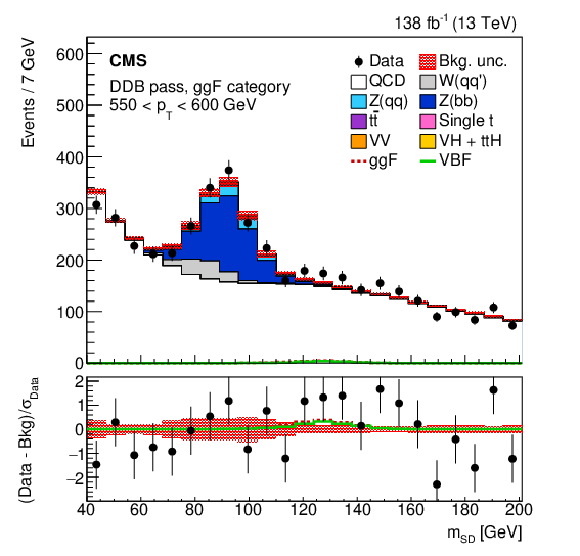
png pdf |
Figure 8-c:
Post-fit soft drop mass distribution in each of the $ {p_{\mathrm{T}}} $ bins in the ggF category, summed over all data-taking periods for display purposes. The DDB pass region is shown. The lower panels show the difference between the data and background prediction divided by the statistical uncertainty in data. The ggF and VBF distributions are overlaid in red and green, respectively. Each signal is scaled to its fitted event yield. |

png pdf |
Figure 8-d:
Post-fit soft drop mass distribution in each of the $ {p_{\mathrm{T}}} $ bins in the ggF category, summed over all data-taking periods for display purposes. The DDB pass region is shown. The lower panels show the difference between the data and background prediction divided by the statistical uncertainty in data. The ggF and VBF distributions are overlaid in red and green, respectively. Each signal is scaled to its fitted event yield. |
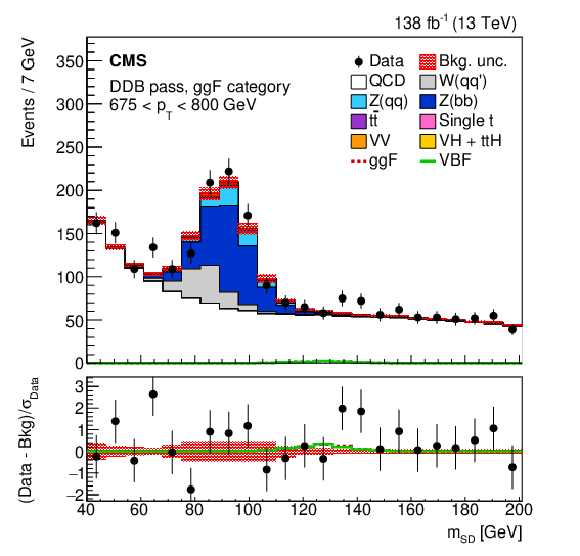
png pdf |
Figure 8-e:
Post-fit soft drop mass distribution in each of the $ {p_{\mathrm{T}}} $ bins in the ggF category, summed over all data-taking periods for display purposes. The DDB pass region is shown. The lower panels show the difference between the data and background prediction divided by the statistical uncertainty in data. The ggF and VBF distributions are overlaid in red and green, respectively. Each signal is scaled to its fitted event yield. |
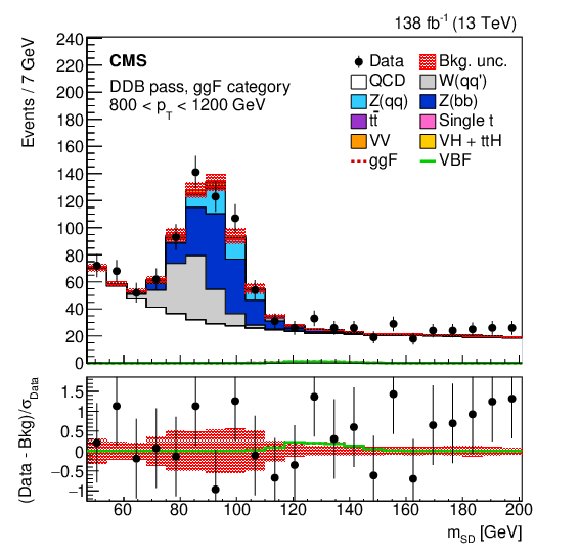
png pdf |
Figure 8-f:
Post-fit soft drop mass distribution in each of the $ {p_{\mathrm{T}}} $ bins in the ggF category, summed over all data-taking periods for display purposes. The DDB pass region is shown. The lower panels show the difference between the data and background prediction divided by the statistical uncertainty in data. The ggF and VBF distributions are overlaid in red and green, respectively. Each signal is scaled to its fitted event yield. |
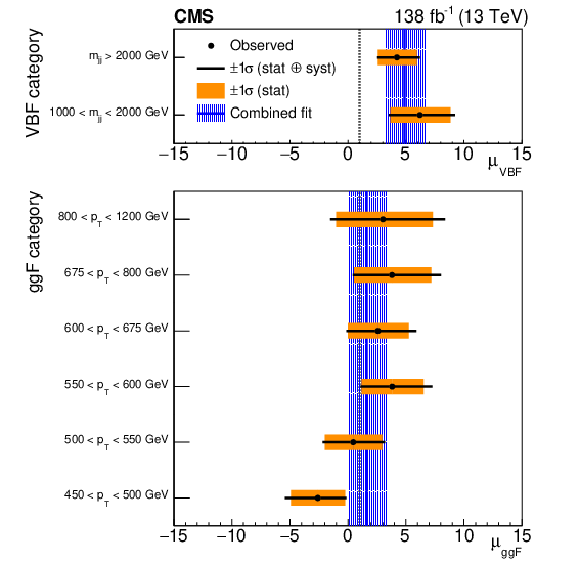
png pdf |
Figure 9:
Upper: the VBF signal strength is shown in black, fitted per $ m_\text{jj} $ bin, with the ratio of the ggF and VBF cross sections fixed to the SM expectation. The horizontal black line represents the total uncertainty, and the orange bar represents the statistical-only component. The combined VBF signal strength and its uncertainty are shown in blue. The SM expectation is shown as a dashed line. Lower: the ggF signal strength is shown in black, fitted per $ p_{\mathrm{T}} $ bin, with the ratio of the ggF and VBF cross sections fixed to the SM expectation. The horizontal black line represents the total uncertainty, and the orange bar represents the statistical-only component. The combined ggF signal strength and its uncertainty are shown in blue. The SM expectation is shown as a dashed line. |
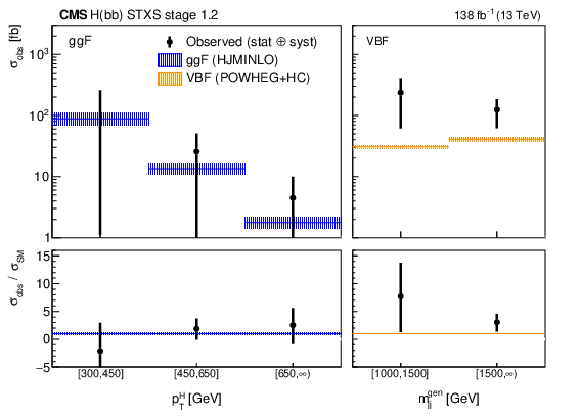
png pdf |
Figure 10:
Unfolded cross section in five of the STXS stage 1.2 bins: three bins of Higgs boson $ p_{\mathrm{T}} $ in ggF, and two bins of generator-level $ m_\text{jj} $ in VBF. The SM prediction from HJMINLO and POWHEG (plus higher order EW and NNLO QCD corrections) is overlaid for the ggF and VBF production mechanisms, respectively. The lower panel shows the ratio of the measured cross section to the SM prediction. |
| Tables | |

png pdf |
Table 1:
Summary of corrections for the jet substructure selection (scale factor $ f_\text{sub} $), jet mass resolution (scale factor $ f_\sigma $), and jet mass scale (shift $ \delta_m $) for different data-taking periods. |

png pdf |
Table 2:
Post-fit and observed data event yield in the single-muon control region for each data-taking period. |

png pdf |
Table 3:
Fitted signal strength for $ \mathrm{H}\to\mathrm{b}\overline{\mathrm{b}} $ in the VBF and ggF channels for each data-taking period and for the full data set. |

png pdf |
Table 4:
Summary of the best fit estimators for the cross sections and their uncertainties. The last column shows the total uncertainty followed by the statistical component in parentheses. |
| Summary |
| A measurement has been performed of boosted Higgs bosons (H) produced via vector boson fusion (VBF) or gluon fusion (ggF) and decaying to bottom quark-antiquark pairs. The analysis goes beyond the inclusive $ \mathrm{H}\to\mathrm{b}\overline{\mathrm{b}} $ measurements performed thus far to provide the first exploration of Higgs bosons produced with high transverse momentum ($ p_{\mathrm{T}} > $ 450 GeV) in the VBF channel. The signal strengths for both processes are extracted simultaneously by performing a maximum likelihood fit to data in the large-radius jet mass distribution. The observed signal strengths for the VBF and ggF processes are 4.9$ ^{+1.9}_{-1.6} $ and 1.6$ ^{+1.7}_{-1.5} $, corresponding to a 2.7$ \sigma $ difference between data and the standard model expectation. The unfolded simplified template cross sections, which will provide an important input to future combined interpretations of H interactions, are also reported. |
| Additional Figures | |
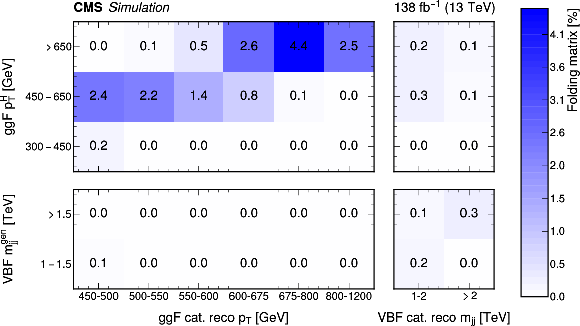
png pdf |
Additional Figure 1:
The unfolding matrix $ M_{ij} $, defined as the product of the acceptance and the efficiency as a percentage for an event in truth bin $ i $ to be found in reconstructed bin $ j $, shown for ggF events simulated with HJMINLO (top) and VBF events simulated with POWHEG reweighted to the NNLO $ p_{\mathrm{T}} $ spectrum and with EW corrections applied (bottom). |
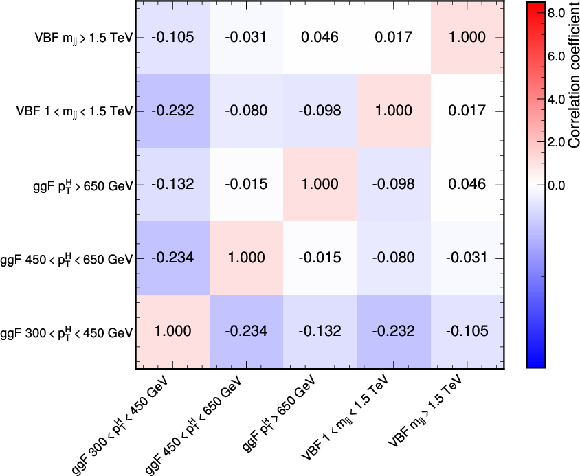
png pdf |
Additional Figure 2:
Correlation coefficients between the truth bins of the differential cross section measurement. |
| References | ||||
| 1 | ATLAS Collaboration | Observation of a new particle in the search for the standard model Higgs boson with the ATLAS detector at the LHC | PLB 716 (2012) 1 | 1207.7214 |
| 2 | CMS Collaboration | Observation of a new boson at a mass of 125 GeV with the CMS experiment at the LHC | PLB 716 (2012) 30 | CMS-HIG-12-028 1207.7235 |
| 3 | CMS Collaboration | Observation of a new boson with mass near 125 GeV in pp collisions at $ \sqrt{s} = $ 7 and 8 TeV | JHEP 06 (2013) 081 | CMS-HIG-12-036 1303.4571 |
| 4 | CMS Collaboration | A portrait of the Higgs boson by the CMS experiment ten years after the discovery | Nature 607 (2022) 60 | CMS-HIG-22-001 2207.00043 |
| 5 | ATLAS Collaboration | A detailed map of Higgs boson interactions by the ATLAS experiment ten years after the discovery | Nature 607 (2022) 52 | 2207.00092 |
| 6 | ATLAS Collaboration | Measurements of Higgs boson production and couplings in diboson final states with the ATLAS detector at the LHC | PLB 726 (2013) 88 | 1307.1427 |
| 7 | A. Salam | Weak and electromagnetic interactions | in Elementary particle physics: relativistic groups and analyticity, N. Svartholm, ed., Almqvist & Wiksell, Stockholm, Proceedings of the eighth Nobel symposium, 1968 | |
| 8 | S. L. Glashow | Partial-symmetries of weak interactions | NP 22 (1961) 579 | |
| 9 | S. Weinberg | A model of leptons | PRL 19 (1967) 1264 | |
| 10 | F. Englert and R. Brout | Broken symmetry and the mass of gauge vector mesons | PRL 13 (1964) 321 | |
| 11 | P. W. Higgs | Broken symmetries, massless particles and gauge fields | PRL 12 (1964) 132 | |
| 12 | P. W. Higgs | Broken symmetries and the masses of gauge bosons | PRL 13 (1964) 508 | |
| 13 | P. W. Higgs | Spontaneous symmetry breakdown without massless bosons | PRL 145 (1966) 1156 | |
| 14 | G. S. Guralnik, C. R. Hagen, and T. W. B. Kibble | Global conservation laws and massless particles | PRL 13 (1964) 585 | |
| 15 | C. Grojean, E. Salvioni, M. Schlaffer, and A. Weiler | Very boosted Higgs in gluon fusion | JHEP 05 (2014) 22 | 1312.3317 |
| 16 | M. Schlaffer et al. | Boosted Higgs shapes | EPJC 74 (2014) 3120 | 1405.4295 |
| 17 | S. Dawson, I. M. Lewis, and M. Zeng | Usefulness of effective field theory for boosted Higgs production | PRD 91 (2015) 074012 | 1501.04103 |
| 18 | M. Grazzini, A. Ilnicka, M. Spira, and M. Wiesemann | Modeling BSM effects on the Higgs transverse-momentum spectrum in an EFT approach | JHEP 03 (2017) 115 | 1612.00283 |
| 19 | F. Maltoni, K. Mawatari, and M. Zaro | Higgs characterisation via vector-boson fusion and associated production: NLO and parton-shower effects | EPJC 74 (2014) 2710 | 1311.1829 |
| 20 | C. Degrande et al. | Electroweak Higgs boson production in the standard model effective field theory beyond leading order in QCD | EPJC 77 (2017) 262 | 1609.04833 |
| 21 | J. R. Andersen et al. | Les Houches 2015: Physics at TeV Colliders Standard Model working group report | in Proc. 9th Les Houches Workshop on Physics at TeV Colliders, Les Houches, 2015 PhysTeV 201 (2015) 5 |
1605.04692 |
| 22 | K. Becker et al. | Precise predictions for boosted Higgs production | SciPost Phys. Core 7 (2024) 001 | 2005.07762 |
| 23 | CMS Collaboration | Inclusive search for a highly boosted Higgs boson decaying to a bottom quark-antiquark pair | PRL 120 (2018) 071802 | CMS-HIG-17-010 1709.05543 |
| 24 | ATLAS Collaboration | Constraints on Higgs boson production with large transverse momentum using $ H\rightarrow b\bar{b} $ decays in the ATLAS detector | PRD 105 (2022) 092003 | 2111.08340 |
| 25 | CMS Collaboration | Inclusive search for highly boosted Higgs bosons decaying to bottom quark-antiquark pairs in proton-proton collisions at $ \sqrt{s}= $ 13 TeV | JHEP 12 (2020) 085 | CMS-HIG-19-003 2006.13251 |
| 26 | ATLAS Collaboration | Measurement of the associated production of a Higgs boson decaying into b-quarks with a vector boson at high transverse momentum in pp collisions at $ \sqrt{s}= $ 13 TeV with the ATLAS detector | PLB 816 (2021) 136204 | 2008.02508 |
| 27 | ATLAS Collaboration | Study of high-momentum Higgs boson production in association with a vector boson in the $ \mathrm{q}\mathrm{q}\mathrm{b}\mathrm{b} $ final state with the ATLAS detector | PRL 132 (2024) 131802 | 2312.07605 |
| 28 | CMS Collaboration | Measurement of simplified template cross sections of the Higgs boson produced in association with W or Z bosons in the $ \mathrm{H}\to\mathrm{b}\overline{\mathrm{b}} $ decay channel in proton-proton collisions at $ \sqrt{s} = $ 13 TeV | PRD 109 (2024) 092011 | CMS-HIG-20-001 2312.07562 |
| 29 | CMS Collaboration | Precision luminosity measurement in proton-proton collisions at $ \sqrt{s} = $ 13 TeV in 2015 and 2016 at CMS | EPJC 81 (2021) 800 | CMS-LUM-17-003 2104.01927 |
| 30 | CMS Collaboration | CMS luminosity measurement for the 2017 data-taking period at $ \sqrt{s} = $ 13 TeV | CMS Physics Analysis Summary, 2018 CMS-PAS-LUM-17-004 |
CMS-PAS-LUM-17-004 |
| 31 | CMS Collaboration | CMS luminosity measurement for the 2018 data-taking period at $ \sqrt{s} = $ 13 TeV | CMS Physics Analysis Summary, 2019 CMS-PAS-LUM-18-002 |
CMS-PAS-LUM-18-002 |
| 32 | CMS Collaboration | Performance of the mass-decorrelated DeepDoubleX classifier for double-b and double-c large-radius jets with the CMS detector | CMS Detector Performance Note CMS-DP-2022-041, 2022 CDS |
|
| 33 | CMS Collaboration | Performance of deep tagging algorithms for boosted double quark jet topology in proton-proton collisions at 13 TeV with the Phase-0 CMS detector | CMS Detector Performance Note CMS-DP-2018-046, 2018 CDS |
|
| 34 | CMS Collaboration | Identification of heavy-flavour jets with the CMS detector in pp collisions at 13 TeV | JINST 13 (2018) P05011 | CMS-BTV-16-002 1712.07158 |
| 35 | CMS Collaboration | The CMS experiment at the CERN LHC | JINST 3 (2008) S08004 | |
| 36 | CMS Collaboration | Performance of the CMS level-1 trigger in proton-proton collisions at $ \sqrt{s}= $ 13 TeV | JINST 15 (2020) P10017 | CMS-TRG-17-001 2006.10165 |
| 37 | CMS Collaboration | The CMS trigger system | JINST 12 (2017) P01020 | CMS-TRG-12-001 1609.02366 |
| 38 | CMS Collaboration | Electron and photon reconstruction and identification with the CMS experiment at the CERN LHC | JINST 16 (2021) P05014 | CMS-EGM-17-001 2012.06888 |
| 39 | CMS Collaboration | Performance of the CMS muon detector and muon reconstruction with proton-proton collisions at $ \sqrt{s}= $ 13 TeV | JINST 13 (2018) P06015 | CMS-MUO-16-001 1804.04528 |
| 40 | CMS Collaboration | Description and performance of track and primary-vertex reconstruction with the CMS tracker | JINST 9 (2014) P10009 | CMS-TRK-11-001 1405.6569 |
| 41 | GEANT4 Collaboration | GEANT 4---a simulation toolkit | NIM A 506 (2003) 250 | |
| 42 | J. Alwall et al. | The automated computation of tree-level and next-to-leading order differential cross sections, and their matching to parton shower simulations | JHEP 07 (2014) 079 | 1405.0301 |
| 43 | J. Alwall et al. | Comparative study of various algorithms for the merging of parton showers and matrix elements in hadronic collisions | EPJC 53 (2007) 473 | 0706.2569 |
| 44 | R. Frederix and S. Frixione | Merging meets matching in MC@NLO | JHEP 12 (2012) 061 | 1209.6215 |
| 45 | S. Kallweit et al. | NLO electroweak automation and precise predictions for W+multijet production at the LHC | JHEP 04 (2015) 012 | 1412.5157 |
| 46 | S. Kallweit et al. | NLO QCD+EW predictions for V+jets including off-shell vector-boson decays and multijet merging | JHEP 04 (2016) 021 | 1511.08692 |
| 47 | S. Kallweit et al. | NLO QCD+EW automation and precise predictions for V+multijet production | in 50th Rencontres de Moriond on QCD and High Energy Interactions, 2015 | 1505.05704 |
| 48 | J. M. Lindert et al. | Precise predictions for $ V $+jets dark matter backgrounds | EPJC 77 (2017) 829 | 1705.04664 |
| 49 | T. Sjöstrand et al. | An introduction to PYTHIA 8.2 | Comput. Phys. Commun. 191 (2015) 159 | 1410.3012 |
| 50 | J. M. Campbell and R. K. Ellis | MCFM for the Tevatron and the LHC | Nucl. Phys. Proc. Suppl. 205-206 (2010) 10 | 1007.3492 |
| 51 | S. Frixione, P. Nason, and C. Oleari | Matching NLO QCD computations with parton shower simulations: the POWHEG method | JHEP 11 (2007) 070 | 0709.2092 |
| 52 | S. Alioli, P. Nason, C. Oleari, and E. Re | A general framework for implementing NLO calculations in shower Monte Carlo programs: the POWHEG BOX | JHEP 06 (2010) 043 | 1002.2581 |
| 53 | S. Frixione, G. Ridolfi, and P. Nason | A positive-weight next-to-leading-order Monte Carlo for heavy flavour hadroproduction | JHEP 09 (2007) 126 | 0707.3088 |
| 54 | R. Frederix, E. Re, and P. Torrielli | Single-top $ t $-channel hadroproduction in the four-flavour scheme with POWHEG and aMC@NLO | JHEP 09 (2012) 130 | 1207.5391 |
| 55 | E. Re | Single-top $ \mathrm{W}\mathrm{t} $-channel production matched with parton showers using the POWHEG method | EPJC 71 (2011) 1547 | 1009.2450 |
| 56 | P. F. Monni et al. | MiNNLO$ _{\text {PS}} $: a new method to match NNLO QCD to parton showers | JHEP 05 (2020) 143 | 1908.06987 |
| 57 | P. F. Monni, E. Re, and M. Wiesemann | MiNNLO$ _{\text {PS}} $: optimizing 2 $ \rightarrow $ 1 hadronic processes | EPJC 80 (2020) 1075 | 2006.04133 |
| 58 | T. Neumann | NLO Higgs+jet production at large transverse momenta including top quark mass effects | J. Phys. Commun. 2 (2018) 095017 | 1802.02981 |
| 59 | P. Nason and C. Oleari | NLO Higgs boson production via vector-boson fusion matched with shower in POWHEG | JHEP 02 (2010) 037 | 0911.5299 |
| 60 | G. Luisoni, P. Nason, C. Oleari, and F. Tramontano | $ \mathrm{H}\mathrm{W}^{\pm} $/$HZ$ $+$0 and 1 jet at NLO with the POWHEG box interfaced to GoSam and their merging within MiNLO | JHEP 10 (2013) 083 | 1306.2542 |
| 61 | H. B. Hartanto, B. Jager, L. Reina, and D. Wackeroth | Higgs boson production in association with top quarks in the POWHEG BOX | PRD 91 (2015) 094003 | 1501.04498 |
| 62 | M. Cacciari et al. | Fully differential vector-boson-fusion Higgs production at next-to-next-to-leading order | PRL 115 (2015) 082002 | 1506.02660 |
| 63 | F. A. Dreyer and A. Karlberg | Vector-boson fusion Higgs production at three loops in QCD | PRL 117 (2016) 072001 | 1606.00840 |
| 64 | CMS Collaboration | Extraction and validation of a new set of CMS PYTHIA 8 tunes from underlying-event measurements | EPJC 80 (2020) 4 | CMS-GEN-17-001 1903.12179 |
| 65 | NNPDF Collaboration | Parton distributions from high-precision collider data | EPJC 77 (2017) 663 | 1706.00428 |
| 66 | CMS Collaboration | Particle-flow reconstruction and global event description with the CMS detector | JINST 12 (2017) P10003 | CMS-PRF-14-001 1706.04965 |
| 67 | M. Cacciari, G. P. Salam, and G. Soyez | The anti-$ k_{T} $ jet clustering algorithm | JHEP 04 (2008) 063 | 0802.1189 |
| 68 | M. Cacciari, G. P. Salam, and G. Soyez | FastJet User Manual | EPJC 72 (2012) 1896 | 1111.6097 |
| 69 | CMS Collaboration | Jet algorithms performance in 13 TeV data | CMS Physics Analysis Summary, 2017 CMS-PAS-JME-16-003 |
CMS-PAS-JME-16-003 |
| 70 | CMS Collaboration | Pileup mitigation at CMS in 13 TeV data | JINST 15 (2020) P09018 | CMS-JME-18-001 2003.00503 |
| 71 | D. Bertolini, P. Harris, M. Low, and N. Tran | Pileup Per Particle Identification | JHEP 10 (2014) 059 | 1407.6013 |
| 72 | CMS Collaboration | Jet energy scale and resolution in the CMS experiment in pp collisions at 8 TeV | JINST 12 (2017) P02014 | CMS-JME-13-004 1607.03663 |
| 73 | D. Krohn, J. Thaler, and L.-T. Wang | Jet Trimming | JHEP 02 (2010) 084 | 0912.1342 |
| 74 | A. J. Larkoski, S. Marzani, G. Soyez, and J. Thaler | Soft Drop | JHEP 05 (2014) 146 | 1402.2657 |
| 75 | ATLAS Collaboration | Measurement of soft-drop jet observables in pp collisions with the ATLAS detector at $ \sqrt{s} = $ 13 TeV | PRD 101 (2020) 052007 | 1912.09837 |
| 76 | I. Moult, L. Necib, and J. Thaler | New Angles on Energy Correlation Functions | JHEP 12 (2016) 153 | 1609.07483 |
| 77 | J. Dolen et al. | Thinking outside the ROCs: Designing Decorrelated Taggers (DDT) for jet substructure | JHEP 05 (2016) 156 | 1603.00027 |
| 78 | E. Bols et al. | Jet flavour classification using DeepJet | JINST 15 (2020) P12012 | 2008.10519 |
| 79 | CMS Collaboration | Performance of the DeepJet b tagging algorithm using 41.9/fb of data from proton-proton collisions at 13 TeV with Phase 1 CMS detector | CMS Detector Performance Note CMS-DP-2018-058, 2018 CDS |
|
| 80 | CMS Collaboration | Performance of missing transverse momentum reconstruction in proton-proton collisions at $ \sqrt{s} = $ 13 TeV using the CMS detector | JINST 14 (2019) P07004 | CMS-JME-17-001 1903.06078 |
| 81 | CMS Collaboration | Performance of reconstruction and identification of $ \tau $ leptons decaying to hadrons and $ \nu_\tau $ in pp collisions at $ \sqrt{s}= $ 13 TeV | JINST 13 (2018) P10005 | CMS-TAU-16-003 1809.02816 |
| 82 | CMS Collaboration | Identification of hadronic tau lepton decays using a deep neural network | JINST 17 (2022) P07023 | CMS-TAU-20-001 2201.08458 |
| 83 | R. A. Fisher | On the interpretation of $ \chi^{2} $ from contingency tables, and the calculation of P | J. R. Stat. Soc. 85 (1922) 87 | |
| 84 | E. Gross and O. Vitells | Trial factors for the look elsewhere effect in high energy physics | EPJC 70 (2010) 525 | 1005.1891 |
| 85 | J. S. Conway | Incorporating Nuisance Parameters in Likelihoods for Multisource Spectra | in orkshop on Statistical Issues Related to Discovery Claims in Search Experiments and Unfolding, 2011 Proceedings of the PHYSTAT 2011 (2011) 115 |
1103.0354 |
| 86 | CMS Collaboration | Performance of heavy-flavour jet identification in boosted topologies in proton-proton collisions at $ \sqrt{s} = $ 13 TeV | Technical Report, 2023 CMS-PAS-BTV-22-001 |
CMS-PAS-BTV-22-001 |
| 87 | CMS Collaboration | Determination of jet energy calibration and transverse momentum resolution in CMS | JINST 6 (2011) P11002 | CMS-JME-10-011 1107.4277 |
| 88 | S. Mrenna and P. Skands | Automated Parton-Shower Variations in PYTHIA 8 | PRD 94 (2016) 074005 | 1605.08352 |
| 89 | J. Butterworth et al. | PDF4LHC recommendations for LHC Run II | JPG 43 (2016) 023001 | 1510.03865 |
| 90 | ATLAS and CMS Collaborations, and LHC Higgs Combination Group | Procedure for the LHC Higgs boson search combination in Summer 2011 | Technical Report CMS-NOTE-2011-005, ATL-PHYS-PUB-2011-11, 2011 | |
| 91 | CMS Collaboration | Precise determination of the mass of the Higgs boson and tests of compatibility of its couplings with the standard model predictions using proton collisions at 7 and 8 TeV | EPJC 75 (2015) 212 | CMS-HIG-14-009 1412.8662 |
| 92 | CMS Collaboration | HEPData record for this analysis | link | |
| 93 | CMS Collaboration | Measurement and interpretation of differential cross sections for Higgs boson production at $ \sqrt{s} = $ 13 TeV | PLB 792 (2019) 369 | CMS-HIG-17-028 1812.06504 |
| 94 | LHC Higgs Cross Section Working Group | Handbook of LHC Higgs Cross Sections: 4. Deciphering the Nature of the Higgs sector | 1610.07922 | |

|
Compact Muon Solenoid LHC, CERN |

|

|

|

|

|

|